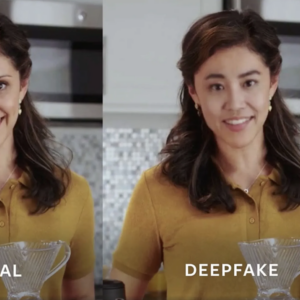TikTokers are using AI to make Professional Headshots: Are there Consequences to Generative AI?
Imagine creating your own professional headshots in a matter of minutes. How about seeing you as an old person? Your future children? Gen Z has adopted image-generative AI to turn their own images into whatever they imagine at the click of a button. Is this newfound creativity harmless, or could this be the start of a dangerous path?
What is Image-generative AI?
Generative image modeling focuses on creating images to resemble photographs, artwork, scenery, etc. in a way that’s accurate and indistinguishable from human-made images. This process usually consists of Generator and Discriminator networks. The Generator creates images based on the request of the user. It then feeds a mix of real and generated images to the Discriminator in an attempt to “fool” it into picking the generated image. In this way, the two networks are trained in an adversarial method, competing with each other so that the processes are constantly advancing.
Some of the most popular AI image generators include DALL-E by OpenAI, the same platform that created ChatGPT. DALL-E provides image outputs based on a text description of concepts, attributes, and styles. You can even input your own image and request highlights, shadows, and textures. Additionally, Midjourney, known for its output efficiency, is hosted on a discord server. Many artists use Midjourney to generate inspiration for their work. In fact, an AI-produced painting, “Théâtre d’Opéra Spatial” by Jason Allen, won first place at the Colorado State Fair in 2022.
AI Contributing to TikTok Trends
Editing apps, which appeal specifically to Gen Z, are also joining in on the AI craze. In fact, the LinkedIn professional headshot trend that has recently gone viral on TikTok is thanks to Remini, an editing app created in 2019 to enhance photo quality. In 2022, the app added an AI generative feature, which further boosted its popularity. The app is present in multiple TikTok trends, racking up millions of views on videos with the #remini hashtag.
For example, TikTok user @gracesplace has over 46 million views on her video showing her AI-generated LinkedIn headshots. In her tutorial, she explains that Remini requires a subscription to use the AI features, but anyone can try them out with the free trial. After choosing 8-12 high-quality images of yourself, you can then scroll through a variety of image templates that range from casual wear to formal wear to different professions. A few minutes later, you’ll be presented with multiple images in the model you selected, and are able to download your favorites.
@gracesplace
Consequences of Image-generative AI
Threatening Artist’s Jobs
In the case of the AI-generated painting, “Théâtre d’Opéra Spatial”, its success at the state fair was met with disdain from other artists. Twitter users argued that the simple outputs of a computer creation took away from the time, effort, and skill put in by other artists. As AI abilities continue to grow, professional artists and illustrators might see less of a demand for their skills. Younger artists may feel discouraged to enter the field, and more controversy could spark over the ethical considerations of AI-generated art.
Despite using AI, Allen claimed that his painting took over 80 hours to produce, as he used multiple platforms including Photoshop to perfect his image. So, while some choose to see AI as a replacement for artists and graphic designers, others see it as a tool to better enhance their work.
Intellectual Property Rights and Fraud
Another concern for artists is the unauthorized use of copyrighted materials in which AI platforms take designs from other pieces of work without permission. This can hurt the artist with the original design, and also the artist behind the AI creation who often is unaware of the copyright infringement.
Even worse, people could take advantage of this ability and sell works with elements of other designs passed as their own. Art collectors could purchase these replicas thinking they’re genuine work, leading to legal disputes and a distrust of originality in the industry.
Deepfakes
Specifically with the technology used in recent TikTok trends, the use of real faces in AI-generated designs can become dangerous. Deepfakes are manipulated photos and videos used to deceive an audience, often replacing faces, voices, and words. So, while someone could edit themselves onto a professional dancer to impress their friends, others could manipulate a politician’s words or defame someone with pornographic material.

With advanced AI, deepfakes are becoming harder to track down. The Pentagon’s Defence Advanced Research Projects Agency (DARPA) is already looking for ways to ban and control deepfakes. Their biggest worry is that image-generative AI platforms become so easily accessible that anyone can injure someone’s reputation, manipulate public opinion, or affect elections.
Conclusion
The lengths of modern technology have allowed for art and entertainment like never before, but with advancement comes consequences. The more that image-generative AI pictures and videos trend on popular social media apps such as TikTok, the more likely it is to get out of control. To protect against the negative aspects of AI, be cautious of what you see and post, cross-check your information, and stay educated on the ever-growing technological capabilities.









